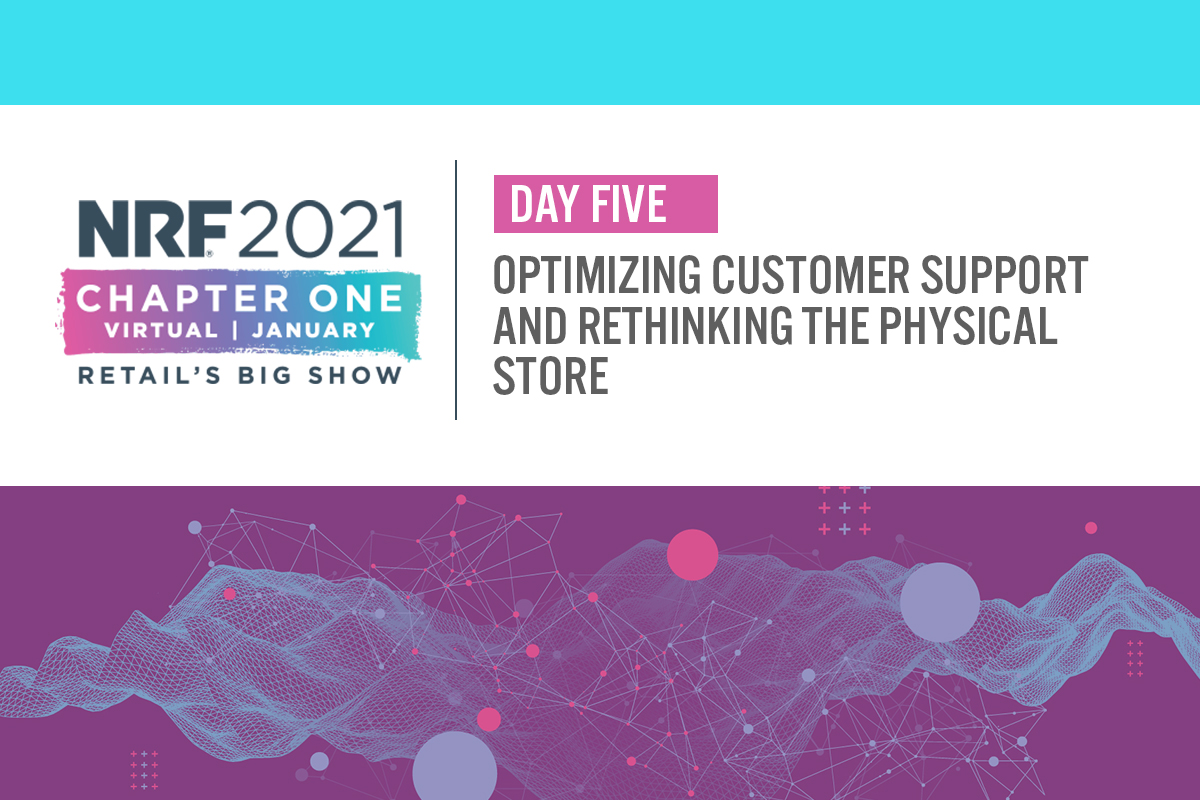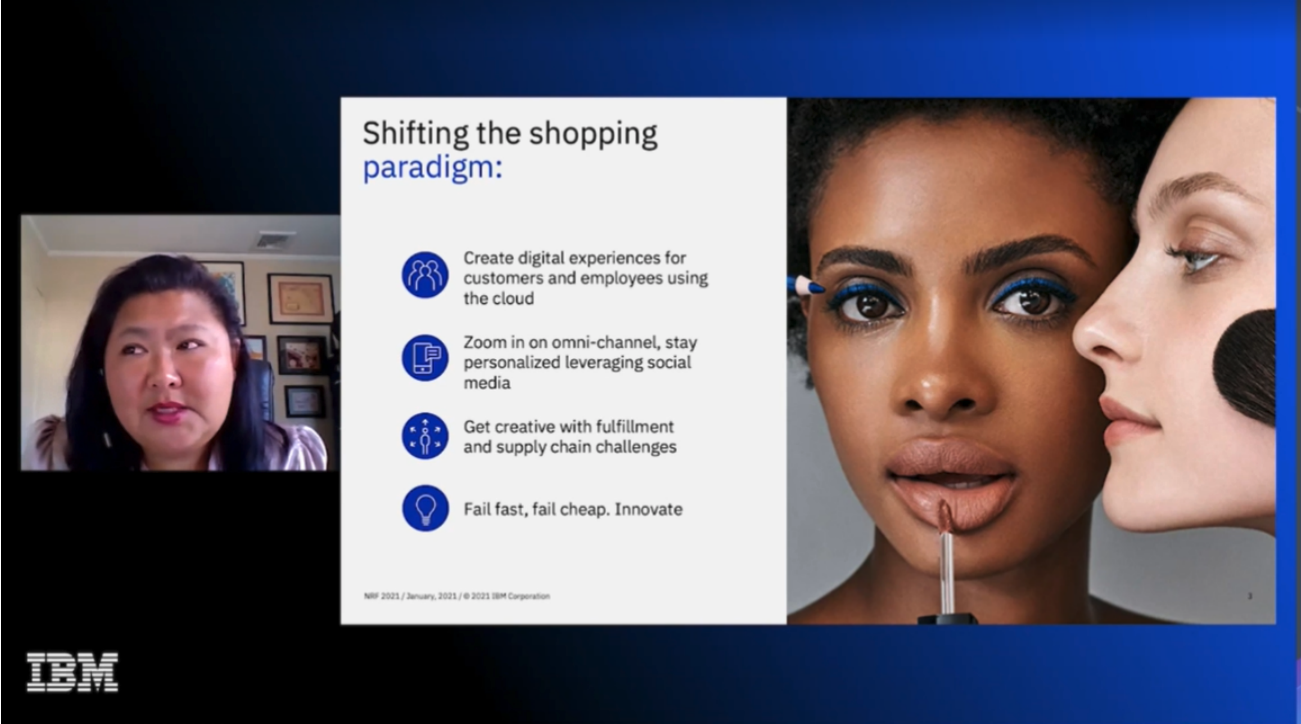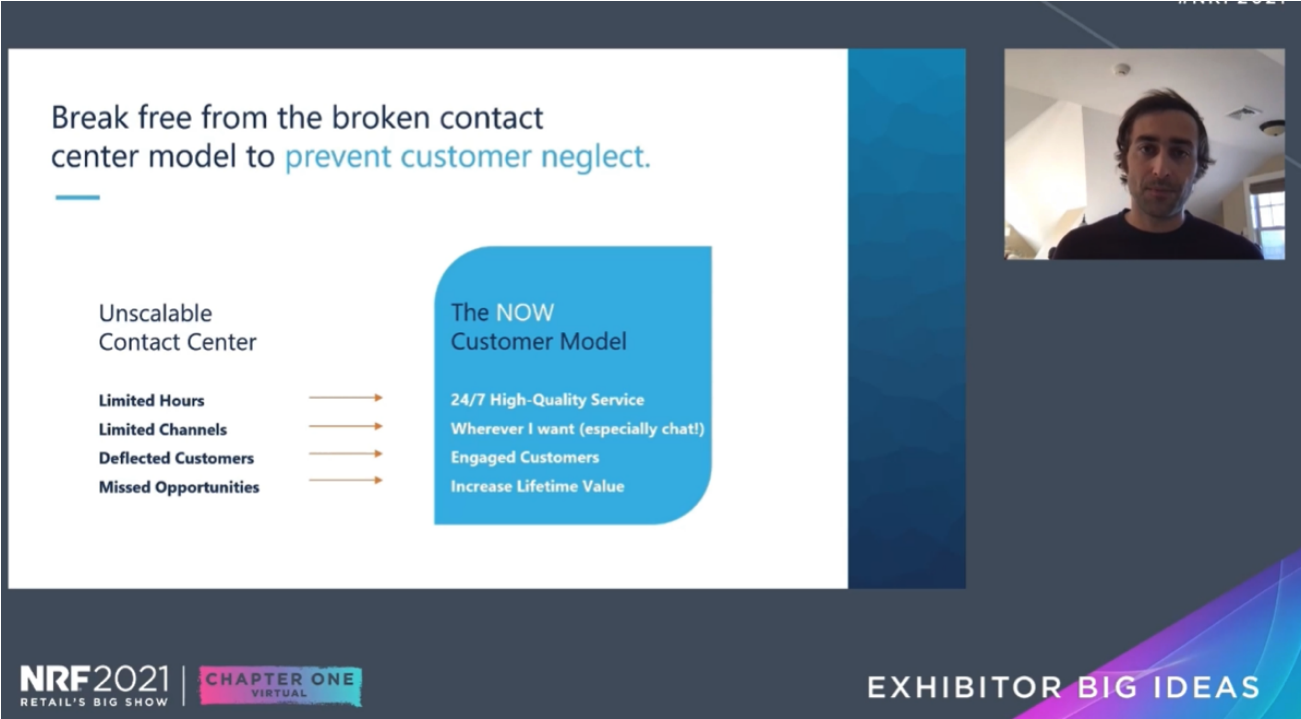
Nitheesh NH
NRF 2021, the annual “Retail’s Big Show” event hosted by the National Retail Federation (NRF), is taking place online over six days between January 12 and 22.
The Coresight Research team is presenting takeaways from each day of the event in separate reports: Read our coverage of day one, day two, day three and day four.
In this report, we offer 10 key insights from day five.
 Kevin Reese, Market Leader of Distribution, AI Applications at IBM, hosted Joe Condomina, Chief Technology Officer at Sally Beauty, and Mary Beth Edwards, Chief Information Officer and Chief Transformation Officer at Sally Beauty, to discuss how Sally Beauty pivoted at the outset of the pandemic
Kevin Reese, Market Leader of Distribution, AI Applications at IBM, hosted Joe Condomina, Chief Technology Officer at Sally Beauty, and Mary Beth Edwards, Chief Information Officer and Chief Transformation Officer at Sally Beauty, to discuss how Sally Beauty pivoted at the outset of the pandemic
Source: NRF[/caption] 2. Salesforce Highlights the Importance of People and Tech in the New World of Retail Rob Garf, Vice President of Strategy and Insights for Retail and Consumer Goods at software firm Salesforce, discussed three major trends that the company has identified in retail over the course of the pandemic, and he highlighted what they mean for the future of the store. First, Garf noted the rapid growth of e-commerce across sectors in 2020. According to Salesforce data, global online sales rose by 55% year over year in the third quarter of 2020, while Cyber Week 2020 (November 24–30) saw 36% year-over-year growth in digital sales. Unsurprisingly, Garf highlighted the importance of focusing on online strategy moving forward. Secondly, he said that there are two areas in which retailers are investing more: technology and people. Garf cited findings from a Salesforce survey conducted in the summer of 2020, in which 76% of retailers reported plans to increase their investments in technology, while 47% stated that they planned to increase their investment in people. Hiring and training the right individuals and investing in technology that streamlines omnichannel capabilities is likely to be a differentiator for retailers in 2021. Finally, Garf spoke of the changing role of the physical store and the importance of adapting locations to facilitate new forms of shopping. For instance, during Cyber Week 2020, retailers that implemented BOPIS (buy online, pick up in store) saw 32% greater digital sales than those that did not, according to Salesforce. Garf expects the reimagination of the role of the store to continue in 2021. 3. For PVH Corp., Retail in 2020 Was Defined by a Focus on Meeting Consumer Needs Janelle Spatz, Director of Operations at US apparel brand owner PVH Corp., spoke on the reactive role that retailers and brands had to play through much of 2020 in order to adapt to a changing retail landscape and shifting customer needs. She said that PVH Corp. had to implement two-to-three years’ worth of strategies in a matter of months near the start of the Covid-19 pandemic, all to adapt to supply chain disruptions and the consumer shift to online shopping. PVH Corp. made several fast changes to its supply chain, including using large regional distribution centers as micro-warehouses to directly ship products to consumers, pulling forward holiday shipping deadlines due to last-mile challenges, and rearranging products kept at different warehouses to minimize the amount of virus-led restrictions any one individual warehouse would have to face. Spatz said that in 2020, PVH Corp. was able to implement technology somewhat reactively, but 2021 would be a year defined by more strategic approaches and the optimization of that technology—echoing a similar point made by Deborah Weinswig, CEO and Founder of Coresight Research, on day four of NRF 2021 4. Integrated Cloud Solutions Can Accelerate Innovation and Improve Agility IBM spoke with David Markwell, Senior Vice President of Technology at Loblaw Companies, about how the Canadian food retail giant has leveraged IBM’s cloud infrastructure to streamline innovation and simplify its data management. According to IBM, 85% of its customers typically use more than one cloud, meaning they use what the company calls a “hybrid cloud.” In order to help retailers consolidate their data into one cloud system, IBM acquired Red Hat, a provider of enterprise open-source solutions. Markwell said that by unifying all of its cloud systems with IBM, Loblaws has been able to drive speed of innovation and adaptability. Having easily accessible amalgamated data has been key to the company’s ability to engage in well-informed pivots quickly during the pandemic, Markwell added. 5. The Store of the Future Will Emphasize Personalized, Purposeful Shopping Experiences A new experimental concept store called CornerShop is set to open at the end of January 2021 in London, UK. The “store of the future” has been devised by a collaboration of three companies: consulting and digital transformation business Capgemini Invent, strategy and marketing agency SharpEnd and marketing and digital news firm The Drum. Leaders from these three businesses took NRF 2021 attendees on a virtual tour of the store. The store aims to offer a personalized and purposeful shopping experience for all consumers. The first time a consumer enters the shop, they will be asked to complete a quick mobile onboarding questionnaire, which will enable the shop to customize the shop’s lighting, music and more according to individual shopper preferences—preferences that will be stored and accessed to offer the same experience on each customer’s return visit. The store will use mobile AR technology to guide shoppers to products according to their preferences and values—for example, taking into account sourcing values and dietary requirements. The result is a unique shopping experience that empowers customers to feel good about what they are buying. 6. Automation and Augmentation Can Reduce In-Store Friction Continuing the tour of CornerShop, Capgemini Invent, SharpEnd and The Drum highlighted the store’s use of automation and augmentation to streamline the shopping experience. For example, the store will feature a coffee bar, where consumers can scan their faces to easily view their order history to make repeat purchases. Further simplifying the in-store experience, CornerShop will feature virtual try-on technology. The store’s smart racks will track which items customers pick up and automatically fit them on a digital rendering of the customer on a large screen near the rack. This is intended to reduce friction and improve conversion rates. [caption id="attachment_122185" align="aligncenter" width="700"] An example of virtual try-on technology at the CornerShop store
An example of virtual try-on technology at the CornerShop store
Source: NRF[/caption] 7. Allbirds Takes a Holistic View of the Customer and Omnichannel Shopping Travis Boyce, Head of Global Retail Operations at footwear retailer Allbirds, spoke on how the company has adjusted its approach during the pandemic to take a holistic view of the customer. Boyce explained that before Covid-19, he spent much of his energy focusing solely on how Allbirds could improve its in-store customer experience, but he now emphasizes the interconnectivity of all shopping channels. Allbirds encourages customers to use stores for omnichannel purposes, including for returns of online orders as this is more sustainable than returns via mail. Looking ahead to a post-pandemic future, Boyce believes that the physical store will have an important role to play: In New Zealand and China, Allbirds is seeing strong foot traffic in stores. 8. Estée Lauder Leverages a Unified Cloud and AI to Improve Customer Support Andrea Chin, Executive Director of Global Consumer Care at The Estée Lauder Companies, discussed how the company has leveraged IBM’s data management and AI solutions to improve its customer service during the pandemic. As a beauty brand owner and retailer, Estée Lauder operates a high-touch business: Consumers typically visit beauty stores to try on different products or sniff perfumes. In light of the global pandemic, the company has had to do its best to provide an equally engaging customer experience via remote channels—with an emphasis on the omnichannel experience. A major element of this shift has been in ensuring high-quality customer support. When supply chain disruptions arose, Estée Lauder had some issues with out-of-stocks and delayed shipments: Chin estimates that eight in 10 inquiries to the company’s call centers were simply asking, “Where is my order?” To empower customer support associates in these difficult situations, Estée Lauder partnered with IBM to ensure associates had constant access to all product stocking and shipment information via a unified cloud. The company also utilized IBM’s AI technology to enable associates to intelligently recommend alternatives to out-of-stock items over the phone or via online chat, helping Estée Lauder to maintain strong, personalized consumer relationships even amid restrictions on in-store shopping. [caption id="attachment_122186" align="aligncenter" width="700"] Andrea Chin, Executive Director of Global Consumer Care at The Estée Lauder Companies, discusses the company’s shift to focus on the omnichannel customer experience
Andrea Chin, Executive Director of Global Consumer Care at The Estée Lauder Companies, discusses the company’s shift to focus on the omnichannel customer experience
Source: Estée Lauder/Coresight Research[/caption] 9. The “Now” Customer Dominates Retail Daniel Rodriguez, Chief Marketing Officer at customer service outsourcing platform Simplr, emphasized at NRF 2021 how demanding today’s consumer has become—describing this as the “now” customer. Counting himself among them, Rodriguez said that consumers now have no patience for brands that cannot communicate with them at a moment’s notice. In a survey of consumers conducted by Simplr in October 2020, 59% of respondents reported that fast response time is the most important part of a customer service experience. Some 60% said they would give an online retailer more business if they received exceptional customer support. Despite the clear importance of speed to consumers, Simplr has found that customer support is still moving too slowly. In an analysis of Black Friday shopping in November 2020, Simplr found that most retailers took more than 24 hours to respond to a presale email. Furthermore, 63% of brands did not have presale live chats available, a feature which Rodriguez argued is among the most effective at increasing conversion rates. Looking ahead, Rodriguez explained that consumers will continue to demand omnichannel, always-on engagement, and reward retailers and brands who deliver it. 10. Retailers Must Engage with Consumers on Their Own Terms After highlighting the rise of the “now” customer, Rodriquez explained how retailers can capitalize on this shift in consumer behavior, and he discussed the potential risks associated with neglecting these consumers. Rodriguez said that for every one customer that leaves a rating, 10 more do not—indicating that a few poor reviews are a lot more worrying than they may appear at first glance. Furthermore, survey data cited by Rodriguez indicates that consumers are influenced by their peers and are not forgiving of businesses: 94% of consumers have been convinced to avoid a business due to a negative online review, and 51% of consumers never interact with a company again after one instance of neglect, according to a 2018 survey by customer review software company ReviewTrackers. In order to avoid the compounding negative effects of a poor customer experience, Rodriguez recommended that retailers provide omnichannel, 24/7 customer support. [caption id="attachment_122187" align="aligncenter" width="700"] Rodriguez, Chief Marketing Officer at Simplr, advises retailers on how to capitalize on the rise of the “now” customer
Rodriguez, Chief Marketing Officer at Simplr, advises retailers on how to capitalize on the rise of the “now” customer
Source: Coresight Research[/caption]
NRF 2021 Day Five: 10 Key Insights
On the fifth day of NRF 2021, discussions centered around improving customer support in the age of digital shopping. Panelists also emphasized the importance of a strong, integrated cloud structure in driving innovation and agility. 1. Sally Beauty Leverages IBM Sterling To Remain Agile In one session on day five of NRF 2021, Kevin Reese, Market Leader of Distribution, AI Applications at IBM, hosted leaders from Sally Beauty to discuss how the company pivoted during the early days of the Covid-19 pandemic. Mary Beth Edwards, Chief Information Officer and Chief Transformation Officer at Sally Beauty, said that although the pandemic has been a difficult time for the company in some ways—it had to furlough some employees and temporarily close stores—the crisis also spurred Sally Beauty to rapidly adopt new innovation in order to become a truly omnichannel retailer. Joe Condomina, Chief Technology Officer at Sally Beauty, explained that the company was able to switch quickly to an online-focused sales model. In just three weeks at the start of the coronavirus outbreak in the US, Sally Beauty rolled out ship-from-store capabilities, using IBM Sterling’s order management system (OMS) to streamline the process. Sally Beauty’s website then saw 10–12 times its normal traffic volumes for a sustained period of several days, which dropped later in the pandemic to a still large 2–2.5 times pre-pandemic volumes. Condomina credited IBM Sterling’s OMS with enabling Sally Beauty to capitalize on consumers’ shift to the online channel, and touted not just the platform’s features but also its relative simplicity to use compared to other OMSs. [caption id="attachment_122184" align="aligncenter" width="700"] Kevin Reese, Market Leader of Distribution, AI Applications at IBM, hosted Joe Condomina, Chief Technology Officer at Sally Beauty, and Mary Beth Edwards, Chief Information Officer and Chief Transformation Officer at Sally Beauty, to discuss how Sally Beauty pivoted at the outset of the pandemic
Kevin Reese, Market Leader of Distribution, AI Applications at IBM, hosted Joe Condomina, Chief Technology Officer at Sally Beauty, and Mary Beth Edwards, Chief Information Officer and Chief Transformation Officer at Sally Beauty, to discuss how Sally Beauty pivoted at the outset of the pandemicSource: NRF[/caption] 2. Salesforce Highlights the Importance of People and Tech in the New World of Retail Rob Garf, Vice President of Strategy and Insights for Retail and Consumer Goods at software firm Salesforce, discussed three major trends that the company has identified in retail over the course of the pandemic, and he highlighted what they mean for the future of the store. First, Garf noted the rapid growth of e-commerce across sectors in 2020. According to Salesforce data, global online sales rose by 55% year over year in the third quarter of 2020, while Cyber Week 2020 (November 24–30) saw 36% year-over-year growth in digital sales. Unsurprisingly, Garf highlighted the importance of focusing on online strategy moving forward. Secondly, he said that there are two areas in which retailers are investing more: technology and people. Garf cited findings from a Salesforce survey conducted in the summer of 2020, in which 76% of retailers reported plans to increase their investments in technology, while 47% stated that they planned to increase their investment in people. Hiring and training the right individuals and investing in technology that streamlines omnichannel capabilities is likely to be a differentiator for retailers in 2021. Finally, Garf spoke of the changing role of the physical store and the importance of adapting locations to facilitate new forms of shopping. For instance, during Cyber Week 2020, retailers that implemented BOPIS (buy online, pick up in store) saw 32% greater digital sales than those that did not, according to Salesforce. Garf expects the reimagination of the role of the store to continue in 2021. 3. For PVH Corp., Retail in 2020 Was Defined by a Focus on Meeting Consumer Needs Janelle Spatz, Director of Operations at US apparel brand owner PVH Corp., spoke on the reactive role that retailers and brands had to play through much of 2020 in order to adapt to a changing retail landscape and shifting customer needs. She said that PVH Corp. had to implement two-to-three years’ worth of strategies in a matter of months near the start of the Covid-19 pandemic, all to adapt to supply chain disruptions and the consumer shift to online shopping. PVH Corp. made several fast changes to its supply chain, including using large regional distribution centers as micro-warehouses to directly ship products to consumers, pulling forward holiday shipping deadlines due to last-mile challenges, and rearranging products kept at different warehouses to minimize the amount of virus-led restrictions any one individual warehouse would have to face. Spatz said that in 2020, PVH Corp. was able to implement technology somewhat reactively, but 2021 would be a year defined by more strategic approaches and the optimization of that technology—echoing a similar point made by Deborah Weinswig, CEO and Founder of Coresight Research, on day four of NRF 2021 4. Integrated Cloud Solutions Can Accelerate Innovation and Improve Agility IBM spoke with David Markwell, Senior Vice President of Technology at Loblaw Companies, about how the Canadian food retail giant has leveraged IBM’s cloud infrastructure to streamline innovation and simplify its data management. According to IBM, 85% of its customers typically use more than one cloud, meaning they use what the company calls a “hybrid cloud.” In order to help retailers consolidate their data into one cloud system, IBM acquired Red Hat, a provider of enterprise open-source solutions. Markwell said that by unifying all of its cloud systems with IBM, Loblaws has been able to drive speed of innovation and adaptability. Having easily accessible amalgamated data has been key to the company’s ability to engage in well-informed pivots quickly during the pandemic, Markwell added. 5. The Store of the Future Will Emphasize Personalized, Purposeful Shopping Experiences A new experimental concept store called CornerShop is set to open at the end of January 2021 in London, UK. The “store of the future” has been devised by a collaboration of three companies: consulting and digital transformation business Capgemini Invent, strategy and marketing agency SharpEnd and marketing and digital news firm The Drum. Leaders from these three businesses took NRF 2021 attendees on a virtual tour of the store. The store aims to offer a personalized and purposeful shopping experience for all consumers. The first time a consumer enters the shop, they will be asked to complete a quick mobile onboarding questionnaire, which will enable the shop to customize the shop’s lighting, music and more according to individual shopper preferences—preferences that will be stored and accessed to offer the same experience on each customer’s return visit. The store will use mobile AR technology to guide shoppers to products according to their preferences and values—for example, taking into account sourcing values and dietary requirements. The result is a unique shopping experience that empowers customers to feel good about what they are buying. 6. Automation and Augmentation Can Reduce In-Store Friction Continuing the tour of CornerShop, Capgemini Invent, SharpEnd and The Drum highlighted the store’s use of automation and augmentation to streamline the shopping experience. For example, the store will feature a coffee bar, where consumers can scan their faces to easily view their order history to make repeat purchases. Further simplifying the in-store experience, CornerShop will feature virtual try-on technology. The store’s smart racks will track which items customers pick up and automatically fit them on a digital rendering of the customer on a large screen near the rack. This is intended to reduce friction and improve conversion rates. [caption id="attachment_122185" align="aligncenter" width="700"]
 An example of virtual try-on technology at the CornerShop store
An example of virtual try-on technology at the CornerShop storeSource: NRF[/caption] 7. Allbirds Takes a Holistic View of the Customer and Omnichannel Shopping Travis Boyce, Head of Global Retail Operations at footwear retailer Allbirds, spoke on how the company has adjusted its approach during the pandemic to take a holistic view of the customer. Boyce explained that before Covid-19, he spent much of his energy focusing solely on how Allbirds could improve its in-store customer experience, but he now emphasizes the interconnectivity of all shopping channels. Allbirds encourages customers to use stores for omnichannel purposes, including for returns of online orders as this is more sustainable than returns via mail. Looking ahead to a post-pandemic future, Boyce believes that the physical store will have an important role to play: In New Zealand and China, Allbirds is seeing strong foot traffic in stores. 8. Estée Lauder Leverages a Unified Cloud and AI to Improve Customer Support Andrea Chin, Executive Director of Global Consumer Care at The Estée Lauder Companies, discussed how the company has leveraged IBM’s data management and AI solutions to improve its customer service during the pandemic. As a beauty brand owner and retailer, Estée Lauder operates a high-touch business: Consumers typically visit beauty stores to try on different products or sniff perfumes. In light of the global pandemic, the company has had to do its best to provide an equally engaging customer experience via remote channels—with an emphasis on the omnichannel experience. A major element of this shift has been in ensuring high-quality customer support. When supply chain disruptions arose, Estée Lauder had some issues with out-of-stocks and delayed shipments: Chin estimates that eight in 10 inquiries to the company’s call centers were simply asking, “Where is my order?” To empower customer support associates in these difficult situations, Estée Lauder partnered with IBM to ensure associates had constant access to all product stocking and shipment information via a unified cloud. The company also utilized IBM’s AI technology to enable associates to intelligently recommend alternatives to out-of-stock items over the phone or via online chat, helping Estée Lauder to maintain strong, personalized consumer relationships even amid restrictions on in-store shopping. [caption id="attachment_122186" align="aligncenter" width="700"]
 Andrea Chin, Executive Director of Global Consumer Care at The Estée Lauder Companies, discusses the company’s shift to focus on the omnichannel customer experience
Andrea Chin, Executive Director of Global Consumer Care at The Estée Lauder Companies, discusses the company’s shift to focus on the omnichannel customer experienceSource: Estée Lauder/Coresight Research[/caption] 9. The “Now” Customer Dominates Retail Daniel Rodriguez, Chief Marketing Officer at customer service outsourcing platform Simplr, emphasized at NRF 2021 how demanding today’s consumer has become—describing this as the “now” customer. Counting himself among them, Rodriguez said that consumers now have no patience for brands that cannot communicate with them at a moment’s notice. In a survey of consumers conducted by Simplr in October 2020, 59% of respondents reported that fast response time is the most important part of a customer service experience. Some 60% said they would give an online retailer more business if they received exceptional customer support. Despite the clear importance of speed to consumers, Simplr has found that customer support is still moving too slowly. In an analysis of Black Friday shopping in November 2020, Simplr found that most retailers took more than 24 hours to respond to a presale email. Furthermore, 63% of brands did not have presale live chats available, a feature which Rodriguez argued is among the most effective at increasing conversion rates. Looking ahead, Rodriguez explained that consumers will continue to demand omnichannel, always-on engagement, and reward retailers and brands who deliver it. 10. Retailers Must Engage with Consumers on Their Own Terms After highlighting the rise of the “now” customer, Rodriquez explained how retailers can capitalize on this shift in consumer behavior, and he discussed the potential risks associated with neglecting these consumers. Rodriguez said that for every one customer that leaves a rating, 10 more do not—indicating that a few poor reviews are a lot more worrying than they may appear at first glance. Furthermore, survey data cited by Rodriguez indicates that consumers are influenced by their peers and are not forgiving of businesses: 94% of consumers have been convinced to avoid a business due to a negative online review, and 51% of consumers never interact with a company again after one instance of neglect, according to a 2018 survey by customer review software company ReviewTrackers. In order to avoid the compounding negative effects of a poor customer experience, Rodriguez recommended that retailers provide omnichannel, 24/7 customer support. [caption id="attachment_122187" align="aligncenter" width="700"]
 Rodriguez, Chief Marketing Officer at Simplr, advises retailers on how to capitalize on the rise of the “now” customer
Rodriguez, Chief Marketing Officer at Simplr, advises retailers on how to capitalize on the rise of the “now” customerSource: Coresight Research[/caption]